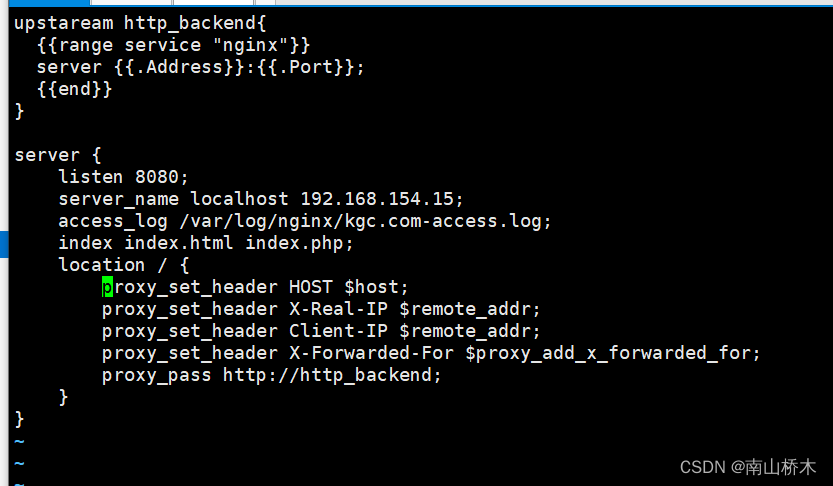- 1微信小程序上传图片的三种方法_微信小程序图片上传
- 2Linux-flink单节点安装(配合Kafka进行吞吐量测试)_flink linux 安装
- 3数据结构— —队列(顺序表实现)_队列初始化
- 4mount,umount命令详解
- 5pg库sharelock_数据库并发事务控制四:postgresql数据库的锁机制二:表锁 <转>
- 6PHP 快速解决跨域问题_php跨域请求解决方案
- 7(2024,Mamba,DiT,之字扫描与空间连续性)ZigMa:之字形 Mamba 扩散模型_zigma:a
- 819.RabbitMQ 延迟消息实现_rabbitmq_delayed_message_exchange-3.3
- 9(2024,条件注意力,外观保持,潜在随机混合)StreamingT2V:从文本进行一致、动态且可扩展的长视频生成
- 10Oracle实用教程(第五版)(Oracle11g版)学生表、课程表、成绩表的创建与数据插入。
Docker consul容器服务更新与发现
赞
踩
一、什么事服务注册与发现
服务注册与发现是微服务架构中不可或缺的重要组件。起初服务都是单节点的,不保障高可用性,也不考虑服务的压力承载,服务之间调用单纯的通过接口访问。直到后来出现了多个节点的分布式架构,起初的解决手段是在服务前端负载均衡,这样前端必须要知道所有后端服务的网络位置,并配置在配置文件中。这里就会有几个问题:
- 如果需要调用后端服务A-N,就需要配置N个服务的网络位置,配置很麻烦
- 后端服务的网络位置变化,都需要改变每个调用者的配置
既然有这些问题,那么服务注册与发现就是解决这些问题的。后端服务A-N可以把当前自己的网络位置注册到服务发现模块,服务发现就以K-V的方式记录下来,K一般是服务名,V就是IP:PORT。服务发现模块定时的进行健康检查,轮询查看这些后端服务能不能访问的了。前端在调用后端服务A-N的时候,就跑去服务发现模块问下它们的网络位置,然后再调用它们的服务。这样的方式就可以解决上面的问题了,前端完全不需要记录这些后端服务的网络位置,前端和后端完全解耦!
二、什么是consul
consul是google开源的一个使用go语言开发的服务管理软件。支持多数据中心、分布式高可用的、服务发现和配置共享。采用Raft算法,用来保证服务的高可用。内置了服务注册与发现框架、分布一致性协议实现、健康检查、Key/Value存储、多数据中心方案,不再需要依赖其他工具(比如ZooKeeper等)。服务部署简单,只有一个可运行的二进制的包。每个节点都需要运行agent,他有两种运行模式server 和 client。 每个数据中心官方建议需要3或5个server节点以保证数据安全,同时保证server-leader的选举能够正确的进行。
在client模式下,所有注册到当前节点的服务会被转发到server节点,本身是不持久化这些信息。
在server模式下,功能和client模式相似,唯一不同的是,它会把所有的信息持久化到本地,这样遇到故障,信息是可以被保留的。
server-leader是所有server节点的老大,它和其它server节点不同的是,它需要负责同步注册的信息给其它的server节点,同时也要负责各个节点的健康监测。
consul提供的一些关键特性:
服务注册与发现:consul通过DNS或者HTTP接口使服务注册和服务发现变的很容易,一些外部服务,例如saas提供的也可以一样注册。
健康检查:健康检测使consul可以快速的告警在集群中的操作。和服务发现的集成,可以防止服务转发到故障的服务上面。
Key/Value存储:一个用来存储动态配置的系统。提供简单的HTTP接口,可以在任何地方操作。
多数据中心:无需复杂的配置,即可支持任意数量的区域。
安装consul是用于服务注册,也就是容器本身的一些信息注册到consul里面,其他程序可以通过consul获取注册的相关服务信息,这就是服务注册与发现。
三、consul部署
consul服务器 192.168.80.15 运行consul服务、nginx服务、consul-template守护进程
registrator服务器 192.168.80.10 运行registrator容器、运行nginx容器
systemctl stop firewalld.service
setenforce 0
- 1
- 2
- 3
- 4
- 5
1、consul服务器
1. 建立 Consul 服务 mkdir /opt/consul cp consul_0.9.2_linux_amd64.zip /opt/consul cd /opt/consul unzip consul_0.9.2_linux_amd64.zip mv consul /usr/local/bin/ //设置代理,在后台启动 consul 服务端 consul agent \ -server \ -bootstrap \ -ui \ -data-dir=/var/lib/consul-data \ -bind=192.168.80.15 \ -client=0.0.0.0 \ -node=consul-server01 &> /var/log/consul.log &
- 1
- 2
- 3
- 4
- 5
- 6
- 7
- 8
- 9
- 10
- 11
- 12
- 13
- 14
- 15
- 16
-server: 以server身份启动。默认是client。
-bootstrap :用来控制一个server是否在bootstrap模式,在一个数据中心中只能有一个server处于bootstrap模式,当一个server处于 bootstrap模式时,可以自己选举为 server-leader。
-bootstrap-expect=2 :集群要求的最少server数量,当低于这个数量,集群即失效。
-ui :指定开启 UI 界面,这样可以通过 http://localhost:8500/ui 这样的地址访问 consul 自带的 web UI 界面。
-data-dir :指定数据存储目录。
-bind :指定用来在集群内部的通讯地址,集群内的所有节点到此地址都必须是可达的,默认是0.0.0.0。
-client :指定 consul 绑定在哪个 client 地址上,这个地址提供 HTTP、DNS、RPC 等服务,默认是 127.0.0.1。
-node :节点在集群中的名称,在一个集群中必须是唯一的,默认是该节点的主机名。
-datacenter :指定数据中心名称,默认是dc1。
netstat -natp | grep consul 启动consul后默认会监听5个端口: 8300:replication、leader farwarding的端口 8301:lan cossip的端口 8302:wan gossip的端口 8500:web ui界面的端口 8600:使用dns协议查看节点信息的端口 2. 查看集群信息 #查看members状态 consul members Node Address Status Type Build Protocol DC consul-server01 192.168.80.15:8301 alive server 0.9.2 2 dc1 #查看集群状态 consul operator raft list-peers consul info | grep leader leader = true leader_addr = 192.168.80.15:8300 3. 通过 http api 获取集群信息 curl 127.0.0.1:8500/v1/status/peers #查看集群server成员 curl 127.0.0.1:8500/v1/status/leader #集群 server-leader curl 127.0.0.1:8500/v1/catalog/services #注册的所有服务 curl 127.0.0.1:8500/v1/catalog/nginx #查看 nginx 服务信息 curl 127.0.0.1:8500/v1/catalog/nodes #集群节点详细信息
- 1
- 2
- 3
- 4
- 5
- 6
- 7
- 8
- 9
- 10
- 11
- 12
- 13
- 14
- 15
- 16
- 17
- 18
- 19
- 20
- 21
- 22
- 23
- 24
- 25
- 26
- 27
- 28
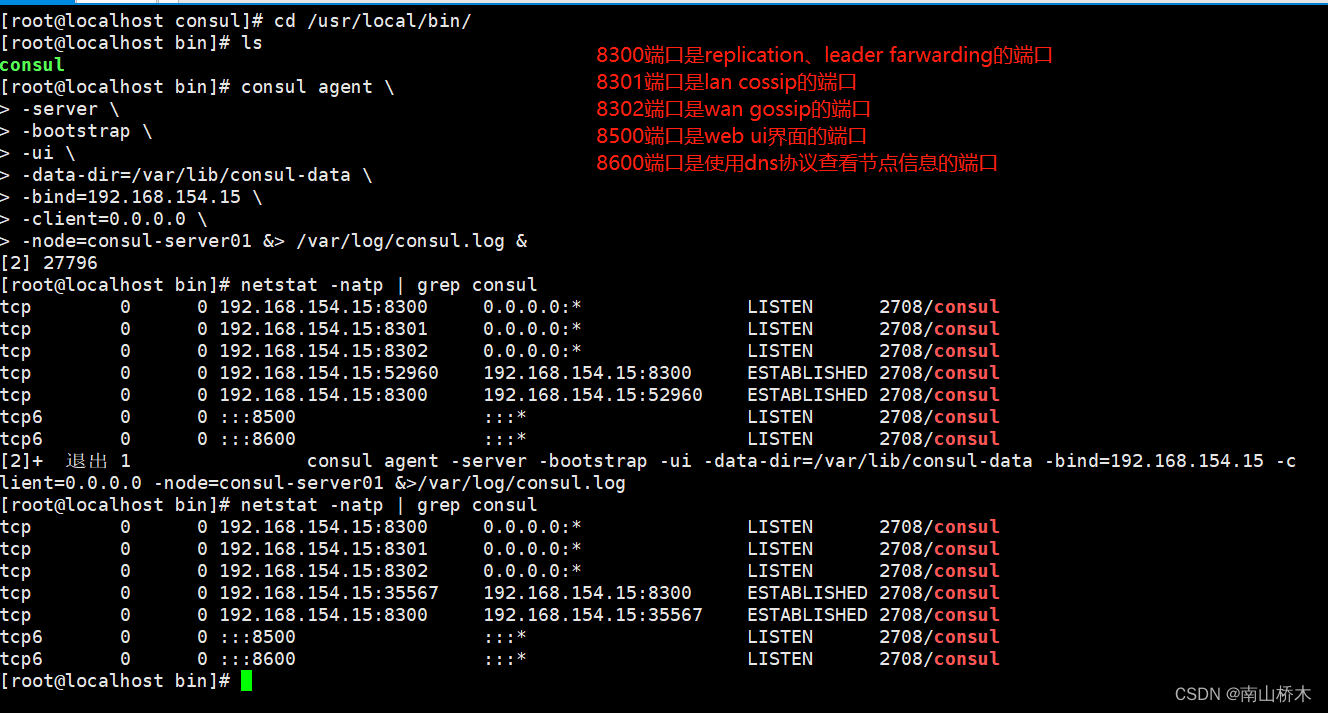



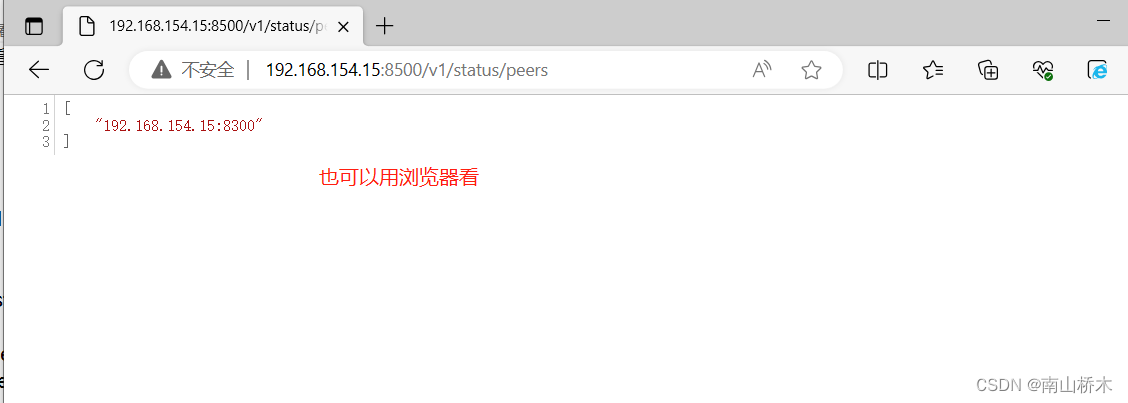
2、registrator服务器
//容器服务自动加入 Nginx 集群
1. 安装 Gliderlabs/Registrator
Gliderlabs/Registrator 可检查容器运行状态自动注册,还可注销 docker 容器的服务到服务配置中心。目前支持 Consul、Etcd 和 SkyDNS2。
docker run -d \
--name=registrator \
--net=host \
-v /var/run/docker.sock:/tmp/docker.sock \
--restart=always \
gliderlabs/registrator:latest \
--ip=192.168.80.14 \
consul://192.168.80.15:8500
- 1
- 2
- 3
- 4
- 5
- 6
- 7
- 8
- 9
- 10
- 11
- 12
–net=host :把运行的docker容器设定为host网络模式。
-v /var/run/docker.sock:/tmp/docker.sock :把宿主机的Docker守护进程(Docker daemon)默认监听的Unix域套接字挂载到容器中。
–restart=always :设置在容器退出时总是重启容器。
–ip :刚才把network指定了host模式,所以我们指定ip为宿主机的ip。
consul :指定consul服务器的IP和端口。
2. 测试服务发现功能是否正常
docker run -itd -p:83:80 --name test-01 -h test01 nginx
docker run -itd -p:84:80 --name test-02 -h test02 nginx
docker run -itd -p:88:80 --name test-03 -h test03 httpd
docker run -itd -p:89:80 --name test-04 -h test04 httpd #-h:设置容器主机名
3. 验证 http 和 nginx 服务是否注册到 consul
浏览器中,输入 http://192.168.80.15:8500,在 Web 页面中“单击 NODES”,然后单击“consurl-server01”,会出现 5 个服务。
//在consul服务器使用curl测试连接服务器
curl 127.0.0.1:8500/v1/catalog/services
{"consul":[],"httpd":[],"nginx":[]}
- 1
- 2
- 3
- 4
- 5
- 6
- 7
- 8
- 9
- 10
- 11
- 12
- 13
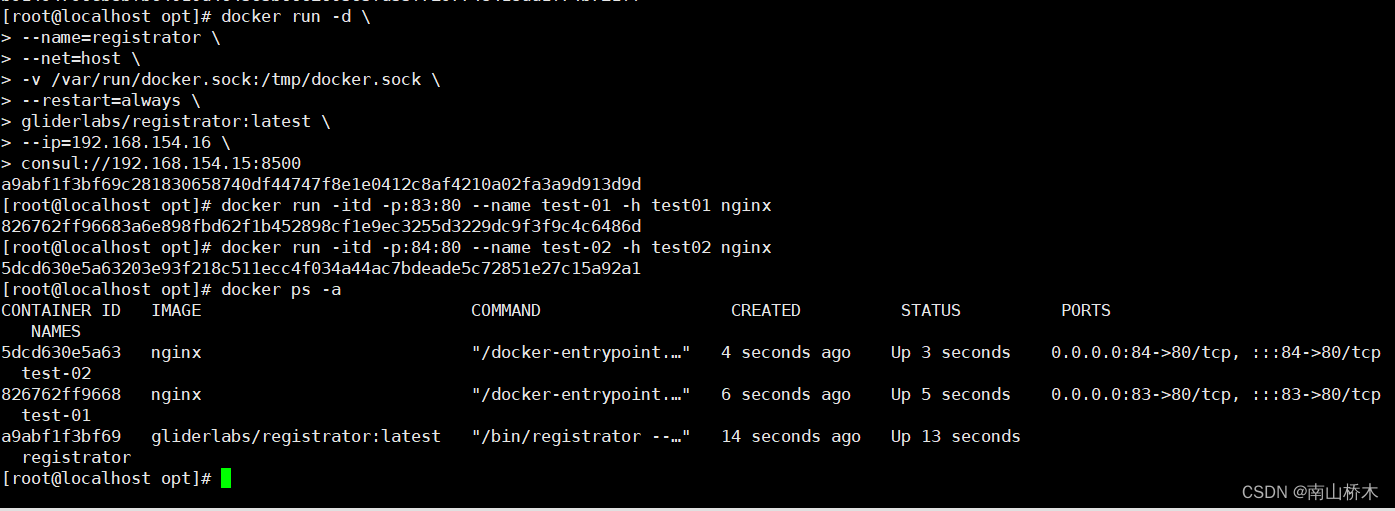
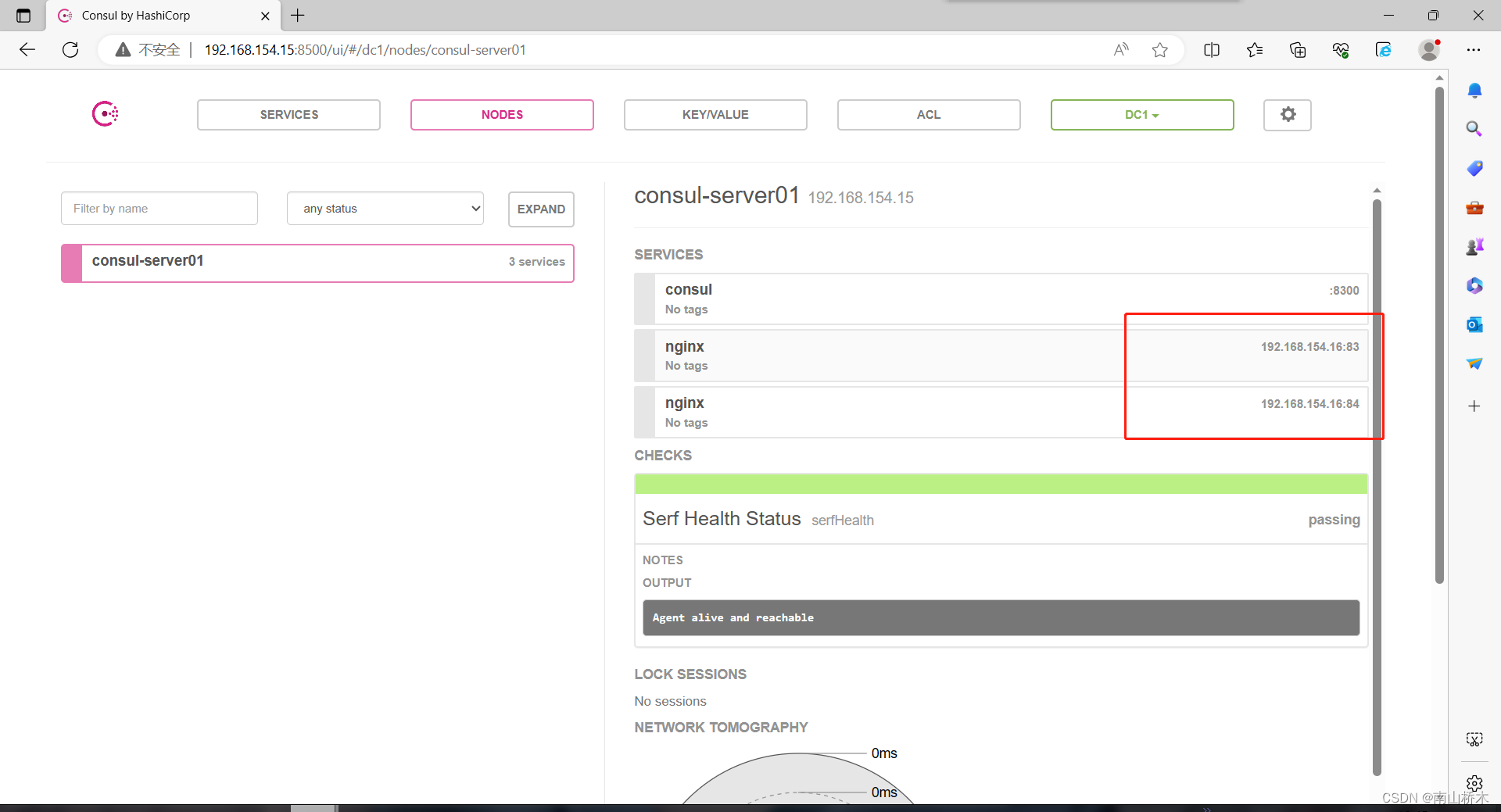
3、consul-template
Consul-Template是基于Consul的自动替换配置文件的应用。Consul-Template是一个守护进程,用于实时查询Consul集群信息,并更新文件系统上任意数量的指定模板,生成配置文件。更新完成以后,可以选择运行 shell 命令执行更新操作,重新加载 Nginx。
Consul-Template可以查询Consul中的服务目录、Key、Key-values 等。这种强大的抽象功能和查询语言模板可以使 Consul-Template 特别适合动态的创建配置文件。例如:创建Apache/Nginx Proxy Balancers 、 Haproxy Backends等。
1. 准备 template nginx 模板文件 //在consul服务器上操作 vim /opt/consul/nginx.ctmpl #定义nginx upstream一个简单模板 upstream http_backend { {{range service "nginx"}} server {{.Address}}:{{.Port}}; {{end}} } #定义一个server,监听8000端口,反向代理到upstream server { listen 8000; server_name localhost 192.168.80.15; access_log /var/log/nginx/kgc.com-access.log; #修改日志路径 index index.html index.php; location / { proxy_set_header HOST $host; proxy_set_header X-Real-IP $remote_addr; proxy_set_header Client-IP $remote_addr; proxy_set_header X-Forwarded-For $proxy_add_x_forwarded_for; proxy_pass http://http_backend; } } 2. 编译安装nginx yum -y install pcre-devel zlib-devel gcc gcc-c++ make useradd -M -s /sbin/nologin nginx tar zxvf nginx-1.12.0.tar.gz -C /opt/ cd /opt/nginx-1.12.0/ ./configure --prefix=/usr/local/nginx --user=nginx --group=nginx && make && make install ln -s /usr/local/nginx/sbin/nginx /usr/local/sbin/ 3. 配置 nginx vim /usr/local/nginx/conf/nginx.conf ...... http { include mime.types; include vhost/*.conf; #添加虚拟主机目录 default_type application/octet-stream; ...... //创建虚拟主机目录 mkdir /usr/local/nginx/conf/vhost //创建日志文件目录 mkdir /var/log/nginx //启动nginx nginx 4. 配置并启动 template unzip consul-template_0.19.3_linux_amd64.zip -d /opt/ cd /opt/ mv consul-template /usr/local/bin/ //在前台启动 template 服务,启动后不要按 ctrl+c 中止 consul-template 进程。 consul-template --consul-addr 192.168.80.15:8500 \ --template "/opt/consul/nginx.ctmpl:/usr/local/nginx/conf/vhost/kgc.conf:/usr/local/nginx/sbin/nginx -s reload" \ --log-level=info //另外打开一个终端查看生成配置文件 upstream http_backend { server 192.168.80.10:83; server 192.168.80.10:84; } server { listen 8000; server_name localhost 192.168.80.15; access_log /var/log/nginx/kgc.cn-access.log; index index.html index.php; location / { proxy_set_header HOST $host; proxy_set_header X-Real-IP $remote_addr; proxy_set_header Client-IP $remote_addr; proxy_set_header X-Forwarded-For $proxy_add_x_forwarded_for; proxy_pass http://http_backend; } } 5. 访问 template-nginx docker ps -a CONTAINER ID IMAGE COMMAND CREATED STATUS PORTS NAMES 9f0dc08956f4 httpd "httpd-foreground" 1 hours ago Up 1 hours 0.0.0.0:89->80/tcp test-04 a0bde07299da httpd "httpd-foreground" 1 hours ago Up 1 hours 0.0.0.0:88->80/tcp test-03 4f74d2c38844 nginx "/docker-entrypoint.…" 1 hours ago Up 1 hours 0.0.0.0:84->80/tcp test-02 b73106db285b nginx "/docker-entrypoint.…" 1 hours ago Up 1 hours 0.0.0.0:83->80/tcp test-01 409331c16824 gliderlabs/registrator:latest "/bin/registrator -i…" 1 hours ago Up 1 hours registrator docker exec -it 4f74d2c38844 bash echo "this is test1 web" > /usr/share/nginx/html/index.html docker exec -it b73106db285b bash echo "this is test2 web" > /usr/share/nginx/html/index.html 浏览器访问:http://192.168.80.15:8000/ ,并不断刷新。 6. 增加一个 nginx 容器节点 (1)增加一个 nginx 容器节点,测试服务发现及配置更新功能。 docker run -itd -p:85:80 --name test-05 -h test05 nginx //观察 template 服务,会从模板更新/usr/local/nginx/conf/vhost/kgc.conf 文件内容,并且重载 nginx 服务。 (2)查看/usr/local/nginx/conf/vhost/kgc.conf 文件内容 cat /usr/local/nginx/conf/vhost/kgc.conf upstream http_backend { server 192.168.80.10:83; server 192.168.80.10:84; server 192.168.80.10:85; } (3)查看三台 nginx 容器日志,请求正常轮询到各个容器节点上 docker logs -f test-01 docker logs -f test-02 docker logs -f test-05 ---------------------------consul 多节点------------------------------ //添加一台已有docker环境的服务器192.168.80.12/24加入已有的群集中 consul agent \ -server \ -ui \ -data-dir=/var/lib/consul-data \ -bind=192.168.80.12 \ -client=0.0.0.0 \ -node=consul-server02 \ -enable-script-checks=true \ -datacenter=dc1 \ -join 192.168.80.15 &> /var/log/consul.log &
- 1
- 2
- 3
- 4
- 5
- 6
- 7
- 8
- 9
- 10
- 11
- 12
- 13
- 14
- 15
- 16
- 17
- 18
- 19
- 20
- 21
- 22
- 23
- 24
- 25
- 26
- 27
- 28
- 29
- 30
- 31
- 32
- 33
- 34
- 35
- 36
- 37
- 38
- 39
- 40
- 41
- 42
- 43
- 44
- 45
- 46
- 47
- 48
- 49
- 50
- 51
- 52
- 53
- 54
- 55
- 56
- 57
- 58
- 59
- 60
- 61
- 62
- 63
- 64
- 65
- 66
- 67
- 68
- 69
- 70
- 71
- 72
- 73
- 74
- 75
- 76
- 77
- 78
- 79
- 80
- 81
- 82
- 83
- 84
- 85
- 86
- 87
- 88
- 89
- 90
- 91
- 92
- 93
- 94
- 95
- 96
- 97
- 98
- 99
- 100
- 101
- 102
- 103
- 104
- 105
- 106
- 107
- 108
- 109
- 110
- 111
- 112
- 113
- 114
- 115
- 116
- 117
- 118
- 119
- 120
- 121
- 122
- 123
- 124
- 125
- 126
- 127
- 128
- 129
- 130
- 131
- 132
- 133
- 134
- 135
- 136
- 137
- 138
- 139
- 140
-enable-script-checks=true :设置检查服务为可用
-datacenter : 数据中心名称
-join :加入到已有的集群中
consul members
Node Address Status Type Build Protocol DC
consul-server01 192.168.80.15:8301 alive server 0.9.2 2 dc1
consul-server02 192.168.80.12:8301 alive server 0.9.2 2 dc1
consul operator raft list-peers
Node ID Address State Voter RaftProtocol
consul-server01 192.168.80.15:8300 192.168.80.15:8300 leader true 2
consul-server02 192.168.80.12:8300 192.168.80.12:8300 follower true 2
- 1
- 2
- 3
- 4
- 5
- 6
- 7
- 8
- 9
